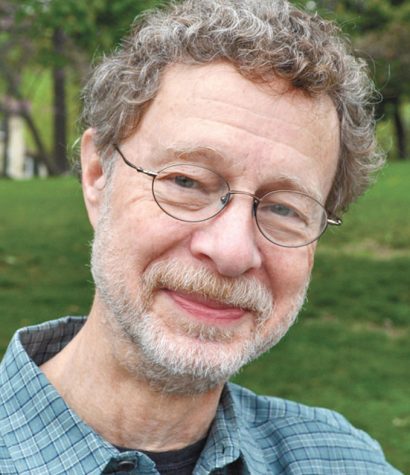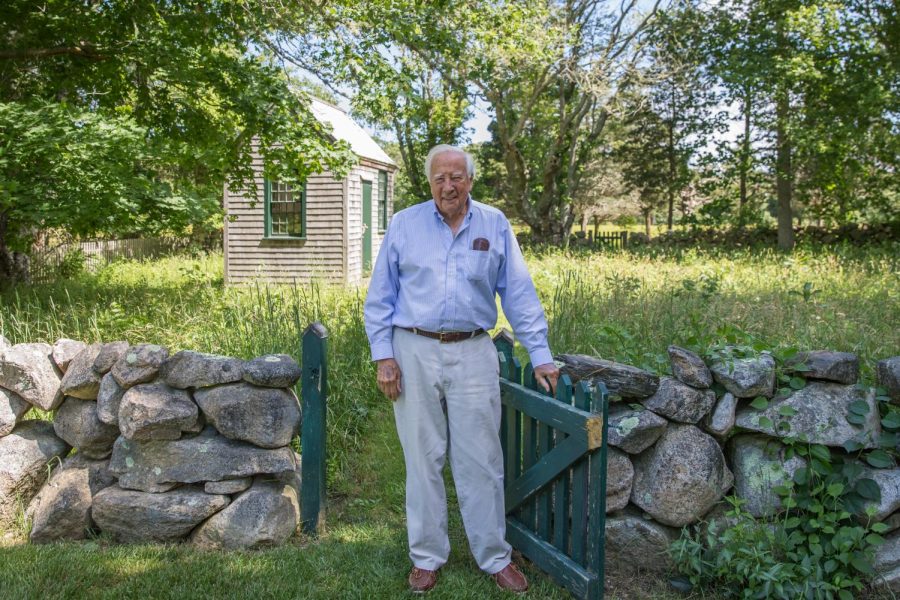Journalist, historian connected by the Brooklyn Bridge
David McCullough in 2019, near the cedar shed he built in the backyard of his home in West Tisbury, Mass., on Martha’s Vineyard, where he did much of his writing. Photo: Maria Thibodeau/Vineyard Gazette
Published August 25, 2022
I met David McCullough for the first time in 1983. Over breakfast. In Phoenix.
As the television critic for the St. Louis Post-Dispatch, I was in Phoenix in June that year with several dozen of my counterparts from other papers across the country covering the semiannual ritual of previews and interviews tied to the coming TV season.
The author-historian was in Phoenix for a PBS presentation about “Smithsonian World,” a nonfiction series scheduled to launch early in 1984. He had signed on as the series host and narrator and participated in a breakfast press conference and question-and-answer period with the journalists.
When I heard earlier this month of McCullough’s death at his home in Hingham, Mass., I was deeply saddened. By all accounts and my own experience, he was an exceptionally decent human being. He also was a brilliant communicator in multiple media with an extraordinary facility for conveying information, inspiration, enlightenment, stories that affirmed our species’ capacity for honorable accomplishments and other stories that confirmed us at our inglorious worst.
I naturally flashed back to our first meeting in Phoenix. I thought about the extended period of years that I’d followed and written for newspapers in St. Louis and then New York about his fine work on television and how he and I had periodically connected in that context. And I remembered a couple of other opportunities I had had to spend some time with him.
McCullough was a month shy of 50 years old when we met in 1983 and already was widely regarded as a master storyteller of history.
He had earned much of that distinction from an early string of remarkable books: “The Johnstown Flood” in 1968; “The Great Bridge” (Brooklyn Bridge) in 1972; “The Path Between the Seas” (Panama Canal) in 1977; and “Mornings on Horseback” (young Theodore Roosevelt) in 1981. The latter two works won prestigious National Book Awards.
By the time we got to Phoenix, McCullough had started working on “Truman.” It took him nine years to finish. It won the Pulitzer Prize for biography.
Meanwhile, McCullough’s television work was developing on a parallel track, beginning with his multiyear collaboration with a young first-time filmmaker named Ken Burns.
Burns’ first documentary and McCullough’s first project with him was “Brooklyn Bridge,” for which McCullough’s “The Great Bridge” was a key source. The Burns film premiered on PBS in 1981 to great acclaim; McCullough narrated it with a rare combination of factual authority and emotional authenticity.
After McCullough’s breakfast session with journalists in Phoenix broke up, I decided to approach him. I introduced myself and asked whether I could tell him about one way his work already had affected my life. He readily agreed.
I began by confessing that I had not yet read “The Great Bridge.” I had read, however, the lengthy cover story he wrote for the Sunday New York Times Magazine of March 27, 1983. It was titled “The Great Bridge and the American Imagination.”
By then, I told him, I already was in love with the Brooklyn Bridge. I had walked across its magnificent pedestrian boardwalk from Manhattan to Brooklyn and back on several occasions and been thoroughly seduced by the bridge’s soaring beauty.

But his Times piece had astonished me, I said, with its stories of the people who were closely involved in designing and building the bridge despite human and technological complexities that took both heroism and tragedy to overcome. He had helped me understand that the completion of the Brooklyn Bridge was itself miraculous, and its design and construction so finely executed that it still was standing — and still working — 100 years later.
I told McCullough that reading his piece in March had so moved me that I hastily (and uncharacteristically) arranged time away from work and home for a solo trip from St. Louis to New York for the official celebration of the Brooklyn Bridge’s centennial in May.
And so it was that on the night of May 24, 1983, 100 years to the day after the bridge opened to the public, I sat with 2.1 million of my closest friends in the middle of New York City’s closed FDR Drive with an unimpeded view of the gorgeous “Brooklyn Bridge” and a breathtaking fireworks display in circumstances like none I’d ever before experienced.
I thanked McCullough for indirectly planting the idea for that trip in my head and heart. He was very pleased, thanked me back, and we exchanged numbers and addresses. He said he hoped we would stay in touch, which we did from time to time.
The time I remember most fondly came several years later on a summer vacation to Martha’s Vineyard, Mass. McCullough and his wife, Rosalee, had a home there in West Tisbury.
I called McCullough a month or so ahead of time and said I’d be coming to the Vineyard with my then-spouse, Claudia (now former spouse and good friend). I asked him if we might get together. He was encouraging about the possibility and asked me to send him the dates of our trip. We should call when we arrived, he said, to see where things stood.
We got to the island some weeks later and called the McCulloughs the next day. David invited us over for a visit and mentioned a possible day and time. We happily agreed.
And so it was that Claudia and I visited with David and Rosalee for a few hours one afternoon at their home on Music Street. They were warm, gracious, at ease, funny, smart and unpretentious. You’d have thought we’d been neighbors for years.
The hours passed too quickly, and we reluctantly said we needed to return to the nearby inn where we were staying. But David had saved a special treat for us. He took us out to the backyard where we saw a tidy but tiny cedar shingle shed, maybe 8 feet by 10 feet. He opened the door and led us inside.
David built it himself with lots of windows for natural light and cross-ventilation but no running water and no phone line. Crammed with bookshelves, tables, a couple of desks and a vintage desk lamp, the space was clearly made for thinking, researching, writing with a pen on pads of paper and typing on a used Royal manual typewriter. He credited it as the instrument with which he had written all his books to date.
David said he periodically would take typed pages of early versions of book sections into the house and hand about half the pages to Rosalee. Then they’d trade off reading passages aloud to each other to get a feeling for the work’s sense and sound. David often referred to Rosalee as his editor-in-chief.
We thanked them many, many times and departed.
It feels appropriate to end this remembrance with a biographical note:
David and Rosalee met as teenagers in 1951, married in 1954 and remained life partners for the next 68 years. Rosalee died this year on June 9 at the age of 89 at their home on Martha’s Vineyard. David died 59 days later on Aug. 7 at their home in Hingham, just south of Boston. He, too, was 89 years old.














